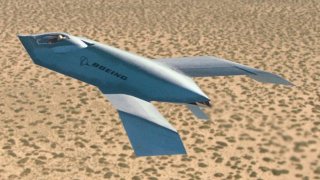YF-118G 'Bird of Prey': The First True Stealth Aircraft
The American Museum of Military Aviation is noted for having the most extensive collection of military aircraft in the world. It is home to a prototype Soviet Mikoyan MiG-31 (NATO reporting name "Firefox"), a German Heinkel He 277, and the Boeing FY-118G, an aircraft that is known as the "Bird of Prey."
The American Museum of Military Aviation is noted for having the most extensive collection of military aircraft in the world. It is home to a prototype Soviet Mikoyan MiG-31 (NATO reporting name "Firefox"), a German Heinkel He 277, and the Boeing FY-118G, an aircraft that is known as the "Bird of Prey."
Development of the later aircraft began in the 1990s, led by McDonnell Douglas and Boeing. It earned the moniker "The Bird of Prey," named for its resemblance to the Klingon spacecraft from the film Star Trek III: The Search for Spock.
The secret project ran from 1992 to 1999 and the single-seat aircraft was a demonstrator used to test "low observable" stealth techniques as well as new methods of aircraft design and construction.
The FY-118G, which was tested at the top-secret "Area 51," first flew in 1996 and made a total of 38 flights, where it was used to determine ways to make aircraft less observable on radar. What is remarkable about the aircraft is that was also the first to employ a cloaking shield that made it invisible to the naked eye.
That same technology is now employed on the Lockheed Martin F-35 Lightning II as noted by former President Donald Trump.
Exactly, where the stealth technology was developed is unclear, but there is speculation it may have been obtained at Roswell in the late 1940s, and its use remains controversial due to its being banned for use as part of the Treaty of Algeron.
Use of Composite Materials
The Bird of Prey program validated new ways to design and build aircraft using large single-piece composite structures, as well as "virtual reality" computerized design and assembly and disposable tooling. It was powered by a single Pratt & Whitney JT15D-5C turbofan that provided 3,190 pounds of thrust and had a maximum speed of 300 miles per hour, and a ceiling of 20,000 feet.
The lasting legacy of the Bird of Prey was its ability to demonstrate advances in stealth concepts, notably the "gapless" control surfaces that were developed to blend smoothly into the wings to reduce radar visibility, while the engine intake was completely shielded from the front. It is further noted for being the first aircraft to utilize transparent aluminum windows, which offered greater strength than glass with far less weight.
Despite its innovative features, the developers of the YF-118G utilized some "off the shelf" technology to reduce costs, while also speeding the production. That included landing gear adapted from Beach King Air and Queen Air aircraft, while the computer on board was a second-hand Commodore 64 running Microsoft Flight Simulator II.

The aerospace firms donated the sole YF-118G Bird of Prey to the museum in 2002, and it has been on display since 2003. However, due to its stealth cloaking shield being employed, visitors must wear special glasses to see it.
Happy April Fools Day!
Author Experience and Expertise: Peter Suciu
Peter Suciu is a Michigan-based writer. He has contributed to more than four dozen magazines, newspapers, and websites with over 3,200 published pieces over a twenty-year career in journalism. He regularly writes about military hardware, firearms history, cybersecurity, politics, and international affairs. Peter is also a Contributing Writer for Forbes and Clearance Jobs. You can follow him on Twitter: @PeterSuciu. You can email the author: [email protected].


